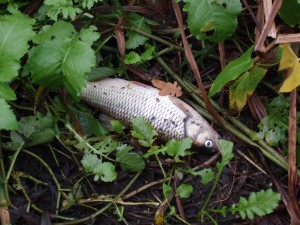Thames Water have been found guilty of negligence over the 2011 River Crane pollution which killed an estimated 10,000 fish and wiped out all life over a 7 mile stretch.
At Isleworth Crown Court on 27th June Thames Water were fined £75000 and order to pay costs of £94000 after the judge found them negligent in their maintenance and operation of the Penstock gate that failed causing the massive pollution incident. The judge found that this was a unique event with two engineering failures, but found Thames Water to have been negligent, to have fallen short of its duty and that there had been a management failure.
Between 29 and 31 October 2011, three discharges of untreated sewage occurred from the two metre diameter trunk foul sewer at Cranford Bridge in Hounslow. The discharge was a result of a jammed penstock gate and failed bypass which blocked the sewer. The untreated sewage entered the River Crane through a storm overflow which is there to prevent properties flooding with sewage during heavy rainfall.
The Court heard how Thames Water commissioned contractors to carry out a survey of the Brent Valley Main Line Sewer. A five tonne penstock gate was closed at Cranford Bridge to reduce flows and enable the safe working of the survey crew in the downstream trunk sewer.
When the survey work was complete, Thames Water’s trunk sewer team tried to raise the penstock but a “sharp crack” was heard and it could not be raised. The lifting mechanism (drive shaft) of the penstock broke when it was being reopened at 4am on 29 October, causing it to become jammed in the closed position. This combined with the failure of the bypass channel resulted in discharges of untreated sewage via the storm overflow into the River Crane.
During the case it was revealed that the bypass channel which is designed to take raw sewage around the Penstock gate had become blocked due to a design fault. The facility was built 80 years ago but Thames Water were unaware of exactly how it should operate.
The incident was categorised as a Category 1, which means major pollution to water quality due to the large fish mortality and severe negative impact on ecology. From the 30 October, there were 44 public reports of dead fish in the River Crane and Duke of Northumberland’s River downstream of Cranford Bridge. Invertebrate surveys and fish carcass counts over the following days and weeks indicated a total loss of all species. It was estimated that over 10,000 coarse fish were killed, 17 species in total including eel, barbel, pike, dace, chub and roach.
David Harvey Chairman of the Thames Anglers Conservancy said: "We are pleased Thames Water have been found guilty of negligence as we have always believed. It is frustrating that not until we have seen the total destruction of a river that Thames Water have started a full review of all similar facilities, this being 25 years since privitisation".
"The Environment Agency have done a great job in getting the right result and proving that Thames Water were negligent. But knowing now that much of the pollution was avoidable leaves a very bitter taste, if Thames had known at the time that the access grill had been blocked and the bypass channel not working, then it is unlikely we would have seen the scale of devastation we did."
David added: "Thames Water did immediately offer a voluntary fund to help restore the river and work towards its future robustness, this fund was agreed at £400000 which does set them apart from other serial polluters. We still would have wanted a much higher fine, one to serve as a real deterrent".
Ruth Shaw, Environment Agency Senior Environment Officer, said: “Our officers attended the site after it became apparent that the incident was very serious. Thames Water’s attempts to raise the penstock and minimise the environmental impact had failed. Raw sewage discharged for 20 hours over the course of two days and sadly all fish and invertebrate life in 15 km of river downstream was killed”.
Ruth Shaw, added: “We take these types of incidents very seriously and will do everything within our powers to safeguard the environment and people affected, and that includes bringing those who harm the environment to account for their actions”.
2011 River Crane Pollution
Copyright of the Thames Anglers Conservancy © 2014


